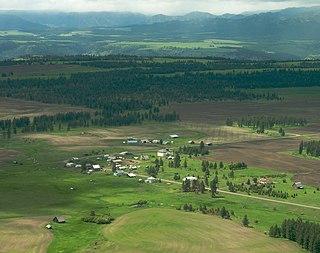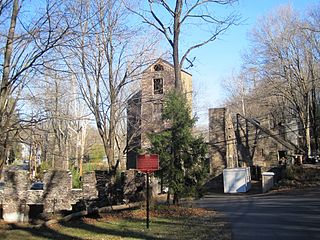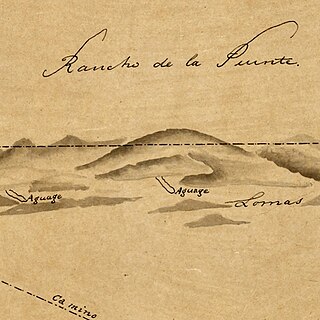
The Geographic Names Information System (GNIS) is a database of name and location information about more than two million physical and cultural features throughout the United States and its territories, Antarctica, and the associated states of the Marshall Islands, Federated States of Micronesia, and Palau. It is a type of gazetteer. It was developed by the United States Geological Survey (USGS) in cooperation with the United States Board on Geographic Names (BGN) to promote the standardization of feature names.

Lida, Nevada is a small ghost town in Esmeralda County, Nevada, near the border with California. The GNIS classifies it as a populated place. It is located on State Route 266, north of Magruder Mountain.
In geography, location or place are used to denote a region on Earth's surface. The term location generally implies a higher degree of certainty than place, the latter often indicating an entity with an ambiguous boundary, relying more on human or social attributes of place identity and sense of place than on geometry. A populated place is called a settlement.

In geography, statistics and archaeology, a settlement, locality or populated place is a community of people living in a particular place. The complexity of a settlement can range from a minuscule number of dwellings grouped together to the largest of cities with surrounding urbanized areas. Settlements may include hamlets, villages, towns and cities. A settlement may have known historical properties such as the date or era in which it was first settled, or first settled by particular people. The process of settlement envolves human migration

Springfield is a famously common place-name in the English-speaking world, especially in the United States. According to the U.S. Geological Survey there are currently 67 populated places named Springfield in the U.S.A. Database studies reveal that there are several more common U.S. place-names than Springfield, including Fairview and Midway. The name "Springfield" is common in Britain and Ireland: two examples being on the outskirts of Shrewsbury, Shropshire, and one located within the borough of Wigan, close to the town centre.

West Point is an unincorporated community and census-designated place in Wayne Township, Tippecanoe County, in the U.S. state of Indiana. The population was 594 at the 2010 census.
The United States Census Bureau defines a place as a concentration of population which has a name, is locally recognized, and is not part of any other place. A place typically has a residential nucleus and a closely spaced street pattern, and it frequently includes commercial property and other urban land uses. A place may be an incorporated place or it may be a census-designated place (CDP). Incorporated places are defined by the laws of the states in which they are contained. The Census Bureau delineates CDPs. A small settlement in the open countryside or the densely settled fringe of a large city may not be a place as defined by the Census Bureau. As of the census, 26% of the people in the United States lived outside of places.
Marshfield is an extinct town in Vienna Township, Scott County, in the U.S. state of Indiana, about three miles northwest of Scottsburg. The GNIS classifies it as a populated place.

Crescent Lake is an unincorporated community and census-designated place (CDP) in Klamath County, Oregon, United States. It is situated 2.5 miles (4.0 km) northeast of Crescent Lake and 2 miles (3.2 km) south of Odell Lake on Oregon Route 58, and is next to Crescent Lake State Airport. Crescent Lake was first listed as a CDP prior to the 2020 census. The north end of the CDP, at the intersection of Route 58 and Crescent Lake Highway, is known as Crescent Lake Junction.
Donnybrook is a historic unincorporated community in Jefferson County, Oregon, United States. Donnybrook is located about 20 miles south of Antelope, and 10 miles east of Ashwood. The area was first known as "Axehandle", and later as "Kilts".
Warren is an unincorporated community in Carbon County, Montana, United States at 45°03′36″N108°39′30″W, elevation 4,419 feet (1,347 m). It is situated on Montana Secondary Highway 310.
Camp Goodwin, and Fort Goodwin, a historical locale, at an elevation of 2648 feet, located in Graham County, Arizona.
Harveyville is a populated place situated in Huntington Township in Luzerne County, Pennsylvania, United States. It is one of two locales in Pennsylvania with the name Harveyville, the other being located in Chester County. It has an estimated elevation of 787 feet (240 m) above sea level.

Hood is a populated place that is located in New Hope, a borough in Bucks County, Pennsylvania, United States.
Heaton is a populated place situated in Pinal County, Arizona, United States. Originally called Maricopa Station, it served as a stop on the railroad line, where passengers transferred to stagecoach. The post office at this location was simply named Maricopa. During a land boom in the late 1880s, it was thought that this stop would become a railway stop on the line directly connecting to Phoenix. As expansion into a town was being considered if the planned rail connection became reality, the expanded community was to be named Maricopaville. In 1887, when the rail line connection went to Maricopa Junction instead, the town's expansion was abandoned, and the name of the town was changed to its current Heaton. It has an estimated elevation of 1,197 feet (365 m) above sea level.
Laguna is a populated place situated in Yuma County, Arizona, United States. It is one of two places in Arizona with this name, the other being located in Pinal County. It has an estimated elevation of 1,608 feet (490 m) above sea level.
Elephant Butte is a populated place on the southeast end of the Elephant Butte Reservoir in Sierra County, New Mexico, United States. It should not be confused with the modern city of Elephant Butte, New Mexico that is on the west side of the reservoir to the northwest of this place. This site lies at an elevation of 4,465 feet and overlooks Elephant Butte to the north, the geographic feature that gives its name to all these locations.

Aguaje is a Spanish word with several meanings related to water. When used for its meaning as a watering place, aguaje is a geographic locale which can be a spring, a stream, arroyo or other natural water feature or a well that reliably provides water for people and their livestock. When used for a natural watering place, the word "abrevadero,", is sometimes used instead.







